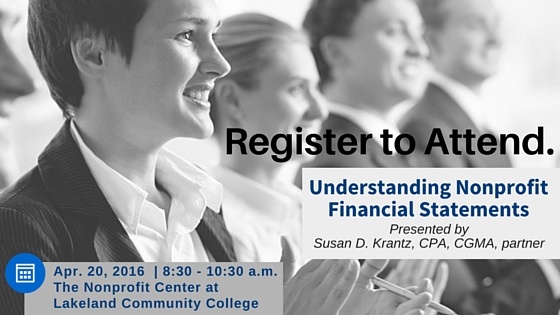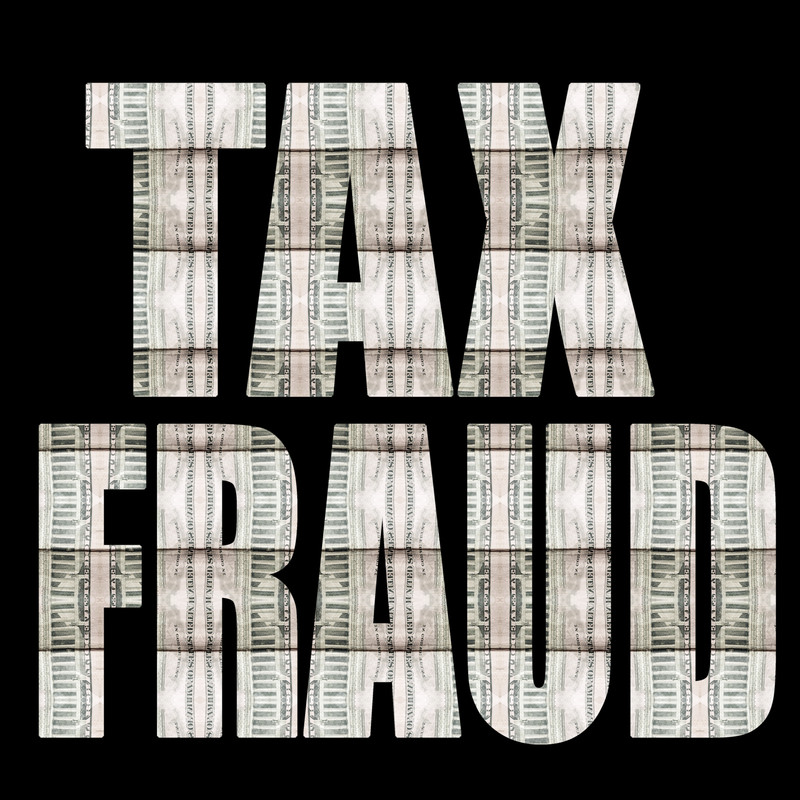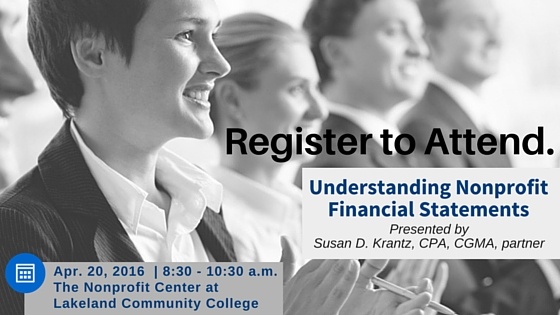Classic Hackers: What War Games Taught us About Technology in the Workplace
Posts By: Zinner & Co.
Don’t panic if you haven’t filed your income tax yet. There’s no time like the present to prepare and file your 2015 tax return.
Everyone involved in leading or managing a nonprofit organization – whether as a board member or as a staff member – needs to comprehend the story behind the numbers.
In fact, providing appropriate oversight of the organization’s finances and being a responsible fiscal steward is a primary fiduciary duty of all trustees.
This important program will not only help non-accountants learn to make sense of financial statements but will also help those in the accounting field understand how nonprofit accounting is different.
"Reading and Understanding Nonprofit Financial Statements" is designed to help all nonprofit leaders and managers:
• Understand basic financial terminology
• Read key documents reflecting the organization’s financial position, activities, cash flows, and functional expenses
• Be capable of judging their soundness
• Recognize warning signs that reflect the health of the organization
• Protect the organization against financial problems and potential fraud
• Ask the right questions
Partner Sue Krantz, CPA, CGMA, will present this session.
Reserve your space today. Registration is open and seating is limited.
Click here to register today!
Registration Code:
16SNPC147.01
Networking and continental breakfast begin at 8:00 a.m.
Fee: $45.00
(includes continental breakfast)
Lakeland Community College
Holden University Center
7700 Clocktower Drive
Kirtland, OH 44094
(immediately across the street
from Lakeland's main campus)
While the logo colors of Zinner & Co. are blue and silver 51 weeks of the year, purple was the weeklong preference from March 21- 26. Purple Day is an annual international celebration to create awareness and support for epilepsy and related seizure disorders. What began as a small initiative in 2008 by a young girl in Nova Scotia is now supported annually on March 26th by people in countries around the world.
“We are thrilled to participate in this annual event. In addition to our deep-rooted spirit of philanthropy, we also work to help others outside the firm learn about and better understand this chronic disorder,” said Partner Sue Krantz, CPA.
Epilepsy affects about 2.3 million adults and 467,000 children 0-17 years of age in the United States, more than Parkinson's disease, cerebral palsy, multiple sclerosis and muscular dystrophy combined. Of the major chronic medical conditions, epilepsy is among the least understood even though 1 in 3 adults knows someone with the disorder.
“Employees have been very creative with their show of support.
In addition to the office adorned with purple flowers and decorations, many made a donation to wear purple clothing throughout the week; some went as far as having purple nail polish, purple glasses and purple tennis shoes,” Krantz added.
"Our Firm brought in lunch from California Pizza Kitchen on the day where they donated a portion of their sales back to the Epilepsy Association." The week concluded with a purple-themed basket raffle and purple snacks and treats.
IRS’s Top 10 Identity Theft Prosecutions: Criminal Investigation Continues Efforts to Halt Refund Fraud
Zinner & Co. identity theft , fraudAs part of the continued crackdown on refund fraud and identity theft, the Internal Revenue Service today released the Top 10 Identity Theft Prosecutions for Fiscal Year 2015. These prosecutions are part of the wide-ranging strategy to combat refund fraud and assist taxpayers through detection, prevention and resolving identity theft cases in a timely manner.
Changes to Household Employment that Will Affect Families in 2016
Zinner & Co. Employee or Independent Contractor , Taxes - IndividualIf you are a family that has privately hired a household employee to provide childcare, senior care, etc., in your home, there’s a relatively low chance that you'll know what aspects of household employment have changed from 2015 to 2016. The good news is that most of the changes are relatively minor, but here are five topics you should be aware of:
The Internal Revenue Service (IRS) recently announced that it is changing the website it uses to collect information from IRS Form 990-N filers. The Form 990-N is a very brief annual filing that smaller tax-exempt organizations are able to utilize in place of submitting the lengthier Form 990-EZ or Form 990. Many state, regional, and local affiliates and chapters of national nonprofit organizations qualify to submit the 990-N.
The Form 990-N submission website will change as of February 29, 2016. All nonprofit organizations submitting Form 990-N should consider filing by February 28, 2016 in order to use the old submission website. Starting February 29, 2016, in order to file the Form 990-N, all nonprofits will be required to complete a one-time registration and file Form 990-N submissions through the IRS’s website at www.irs.gov.
Who Must File the Form 990-N
The Form 990-N is a short, 8-question filing that must be filed by organizations whose annual gross receipts are normally $50,000 or less. An organization meets this criterion if it:
Clients. Culture. Community.
It's not about the work we do; it's about the people we serve.
About Us

Since 1938, Zinner has counseled individuals and businesses from start-up to succession. At Zinner, we strive to ensure we understand your business and recognize threats that could impact your financial situation.
Recent Blog Posts
Categories
- 1031 Exchange (2)
- 401k (2)
- 529 plan (4)
- ABLE Act (1)
- account systems (3)
- accounting (8)
- Affordable Care Act (8)
- alimony (2)
- American Rescue Plan Act (1)
- Ask the Expert (5)
- Audit and Assurance Department (13)
- audits (8)
- Bank Secrecy Act (1)
- banks (1)
- Barbara Theofilos (6)
- Beneficial Ownership Information (1)
- Bitcoin (1)
- block chain (2)
- BOI (3)
- Bookkeeping (1)
- Brett W. Neate (28)
- budgets (1)
- Bureau of Worker's Compensation (12)
- Business - Management, Issues & Concerns (51)
- business income deduction (3)
- business succession (7)
- business travel expense (3)
- business valuation (5)
- capital gains (2)
- careers (7)
- cash flow (2)
- Charitable Donations (1)
- Child Tax Credit (2)
- Chris Valponi (8)
- City of Cleveland (1)
- Cleveland COVID-19 Rapid Response Fund (1)
- Cleveland Rape Crisis Center (2)
- college (3)
- Community (24)
- Compliance (1)
- Coronavirus (24)
- Corporate Transparency Act (1)
- COVID-19 (30)
- Credit card fraud (5)
- credit reporting (2)
- cryptocurrency (2)
- CTA (2)
- cybersecurity (17)
- dead (1)
- DeAnna Alger (6)
- death (2)
- debt (4)
- deductions (14)
- Deferring Tax Payments (4)
- Department of Job and Family Services (2)
- depreciation (1)
- Digital Tax Payment (3)
- divorce (4)
- DOMA (3)
- Economic Impact Payments (2)
- Economic Injury Disaster Loan (4)
- education (8)
- EIDL (1)
- electronic filing (4)
- Electronic Tax Payments (3)
- Emergency Working Capital Program (1)
- employee benefit plan auditor (1)
- Employee Leave (3)
- Employee or Independent Contractor (6)
- Employee Retention Credit (3)
- employment (2)
- ERC (3)
- Eric James (8)
- Estates, Gifts & Trusts (48)
- expenses (5)
- Families First Coronavirus Response Act (2)
- FASB (1)
- FBAR (1)
- FDIC coverage (1)
- Federal Assistance (4)
- filing (3)
- financial planning (8)
- Financial Planning - College (9)
- financing (3)
- Firm news (119)
- first responders (1)
- FMLA (1)
- foreign assets (3)
- fraud (38)
- FSA (1)
- fundraising (9)
- Gabe Adler (1)
- gift tax (5)
- HDHP (2)
- health care (3)
- home (2)
- home office (1)
- Howard Kass (2)
- HRA (1)
- HSA (5)
- identity theft (34)
- income (1)
- income tax (58)
- independent contractor (1)
- Inflation (1)
- Insurance (7)
- internal control (4)
- international (2)
- Intuit (1)
- investments (4)
- IRS (91)
- jobs (5)
- John Husted (1)
- K-1 (1)
- Laura Haines (3)
- Layoff (2)
- Layoffs (1)
- leadership (3)
- lease accounting standards (1)
- life insurance (1)
- LLC (3)
- Loans (2)
- longevity income annuities (1)
- Lorenzo's Dog Training (1)
- Magic of Lights (1)
- management advisory (3)
- manufacturing (2)
- Matt Szydlowski (3)
- medical (7)
- Medicare (2)
- mergers and acquisitions (1)
- Mike DeWine (2)
- Millennial Concepts (2)
- minimum wage (1)
- NAIOP (1)
- National Defense Act (1)
- non-profit reporting (10)
- non-profits (38)
- not-for-profit (26)
- OATC (1)
- OBBB (3)
- ODJFS (1)
- office (1)
- ohio (13)
- Ohio Accounting Talent Coalition (1)
- Ohio business owners (18)
- Ohio Department of Jobs and Family Services (4)
- Ohio Department of Taxation (7)
- Ohio Incumbent Workforce Training Voucher Program (1)
- Ohio Society of Certified Public Accountants (1)
- One Big Beautiful Bill (5)
- Online Tax Payment (4)
- Operations (2)
- OPERS (1)
- OSCPA (1)
- owners of foreign entities (1)
- partnerships (5)
- passwords (1)
- Paycheck Protection Program (9)
- payroll (8)
- penalties (3)
- pension (2)
- personal finance (2)
- planning (4)
- ppp (7)
- Productivity (5)
- Qualified Business Income (1)
- quickbooks (10)
- real estate (14)
- record retention (2)
- records (2)
- Reporting (1)
- Republican National Convention (1)
- Retirement Planning & IRAs (53)
- Richard Huszai, CPA (5)
- RITA (1)
- Robin Baum (6)
- RRF (1)
- S Corporation (1)
- SALT (8)
- SBA (8)
- scams (14)
- SECURE 2.0 Act (1)
- security (6)
- SharedWorks (1)
- Shutdown (3)
- Silver Linings (9)
- simplified employee pension (1)
- Small Business (5)
- SMB (12)
- Social Media (1)
- social security (4)
- Speaker Series (2)
- spouse (1)
- start ups (8)
- Stay at Home Order (3)
- Steven Mnuchin (1)
- Sue Krantz (6)
- SVOG (1)
- tangible property (1)
- tax (27)
- tax avoidance (12)
- Tax Credit (7)
- Tax Cuts and Jobs Act of 2017 (31)
- Tax Exempt (1)
- Tax Holiday (1)
- Tax Interns (2)
- tax services (28)
- taxes (45)
- Taxes - Corporate & Business (105)
- Taxes - Individual (122)
- Taxes - Planning, Rules and Returns (194)
- TechCred (1)
- technology (8)
- The CARES Act (6)
- The SOURCE (1)
- tiag (3)
- transaction advisory (2)
- Treasury Department (5)
- tuition (3)
- U.S. Department of the Treasury (1)
- U.S. Small Business Administration (6)
- Unclaimed Funds (1)
- Unemployment Benefits (4)
- Unemployment Insurance (1)
- withdrawls (2)
- withholding (6)
- Workers Comp Billing Changes (1)
- Zinner & Co. (35)
- Zinner News (32)












